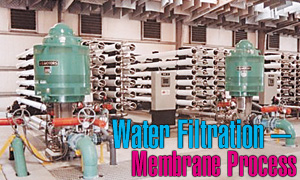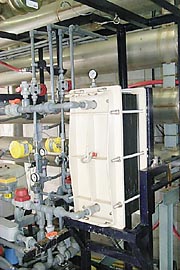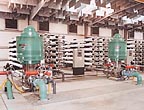
In nature, membranes play an important role in the separation of salts, incluing both the processes of dialysis and osmosis that occur in the body. Membranes are used in two commercially important desalting processes – electrodialysis (ED) and reverse osmosis (RO). Each process uses the ability of the membranes to differentiate and selectively separate salts and water. However, membranes are used differently in each of these processes.
Electrodialysis uses an electrical potential to move salts selectively through a membrane, leaving fresh water behind as product water. In the RO process, pressure is used for separation by allowing fresh water to move through a membrane, leaving the salts behind. Both of these concepts have been explored by scientists since the turn of the century, but their commercialization for desalting water for municipal purposes has occurred only in the last 30 years.

Electrodialysis
Electrodialysis was commercially introduced in the early 1960s – about 10 years before reverse osmosis. The development of electrodialysis provided a cost-effective way to desalt brackish water and spurred considerable interest in this area.Electrodialysis depends on the following general principles:
- Most salts dissolved in water are ionic, being positively (cationic) or negatively (anionic) charged.
- These ions are attracted to electrodes with an opposite electric charge.
- Membranes can be constructed to permit selective passage of either anions or cations.
The dissolved ionic constituents in a saline solution such as Na+, Ca2+ and CO32- are dispersed in water, effectively neutralizing their individual charges. When electrodes connected to an outside source of direct current like a battery are placed in a container of saline water, electrical current is carried through the solution, with the ions tending to migrate to the electrode with the opposite charge.
For these phenomena to desalinate water, membranes that will allow either cations or anions (but not both) to pass are placed between a pair of electrodes. These membranes are arranged alternately with an anion-selective membrane followed by a cation-selective membrane. A spacer sheet that permits water to flow along the face of the membrane is placed between each pair of membranes.
One spacer provides a channel that carries feed (and product) water, while the next carries brine. As the electrodes are charged and saline feed water flows along the product water spacer at right angles to the electrodes, the anions in the water are attracted and diverted toward the positive electrode. This dilutes the salt content of the water in the product water channel. The anions pass through the anion-selective membrane, but cannot pass any farther than the cation-selective membrane, which blocks its path and traps the anion in the brine. Similarly, cations under the influence of the negative electrode move in the opposite direction through the cation-selective membrane to the concentrate channel on the other side. Here, the cations are trapped because the next membrane is anion-selective and prevents further movement toward the electrode.
By this arrangement, concentrated and diluted solutions are created in the spaces between the alternating membranes. These spaces, bounded by two membranes (one anionic and the other cationic) are called cells. The cell pair consists of two cells, one from which the ions migrated (the dilute cell for the product water) and the other in which the ions concentrate (the concentrate cell for the brine stream).
The basic electrodialysis unit consists of several hundred cell pairs bound together with electrodes on the outside and is referred to as a membrane stack. Feed water passes simultaneously in parallel paths through all of the cells to provide a continuous flow of desalted water and brine to emerge from the stack. Depending on the design of the system, chemicals may be added to the streams in the stack to reduce the potential for scaling.
The raw feed water must be pre-treated to prevent materials that could harm the membranes or clog the narrow channels in the cells from entering the membrane stack. The feed water is circulated through the stack with a low-pressure pump with enough power to overcome the resistance of the water as it passes through the narrow passages. A rectifier generally is used to transform alternating current to the direct current supplied to the electrodes on the outside of the membrane stacks.
Post-treatment consists of stabilizing the water and preparing it for distribution. This post-treatment might consist of removing gases such as hydrogen sulfide and adjusting the pH.
Going the Other Way
In the early 1970s, the electrodialysis reversal (EDR) process was commercially introduced for electrodialysis. An EDR unit operates on the same general principle as a standard electrodialysis plant except that both the product and the brine channels are identical in construction. At intervals of several times an hour, the polarity of the electrodes is reversed, and the flows are simultaneously switched so that the brine channel becomes the product water channel, and the product water channel becomes the brine channel.
The result is that the ions are attracted in the opposite direction across the membrane stack. Immediately following the reversal of polarity and flow, enough of the product water is dumped until the stack and lines are flushed out, and the desired water quality is restored. This flush takes about one or two minutes, and then the unit can resume producing water. The reversal process is useful in breaking up and flushing out scales, slimes and other deposits in the cells before they can build up and create a problem. Flushing allows the unit to operate with fewer pretreatment chemicals and minimizes membrane fouling.

Reverse Osmosis
In comparison to electrodialysis, reverse osmosis (RO) is relatively new, with successful commercialization occurring in the early 1970s. RO is a membrane separation process in which the water from a pressurized saline solution is separated from the solutes (the dissolved material) by flowing through a membrane. No heating or phase change is necessary for this separation. The major energy required for desalting is for pressurizing the feed water.In practice, the saline feed water is pumped into a closed vessel where it is pressurized against the membrane. As a portion of the water passes through the membrane, the remaining feed water increases in salt concentration. At the same time, a portion of this feed water is discharged without passing through the membrane.
Without this controlled discharge, the pressurized feed water would continue to increase in salt concentration, creating such problems as precipitation of supersaturated salts and increased osmotic pressure across the membranes. The amount of the feed water discharged to waste in this brine stream varies from 20 percent to 70 percent of the feed flow, depending on the salt content of the feed water.
Pretreatment is important in RO because the feed water must pass through very narrow passages during the process. Therefore, suspended solids must be removed and the water pre-treated so that salt precipitation or microorganism growth does not occur on the membranes. Usually the pretreatment consists of fine filtration and the addition of acid or other chemicals to inhibit precipitation
The high-pressure pump supplies the pressure needed to enable the water to pass through the membrane and have the salts rejected. This pressure ranges from 250 psi to 400 psi for brackish water, and from 800 psi to 1,180 psi for sea water.
The membrane assembly consists of a pressure vessel and a membrane that permits the feed water to be pressurized against the membrane. The membrane must be able to withstand the drop of the entire pressure across it. These semi-permeable membranes are fragile and vary in their ability to pass fresh water and reject the passage of salts. No membrane is perfect in its ability to reject salts, so a small amount of salts passes through the membrane and appears in the product water.
RO membranes are made in a variety of configurations. Two of the most commercially successful are spiral-wound and hollow fine fiber. Both of these configurations are used to desalt both brackish and sea water, although the construction of the membrane and pressure vessel will vary depending on the manufacturer and expected salt content of the feed water.
Post-treatment consists of stabilizing the water and preparing it for distribution. This post-treatment might consist of the removing gases such as hydrogen sulfide and adjusting the pH.
Two developments have helped to reduce the operating cost of RO plants during the past decade – the development of membranes that can operate efficiently with lower pressures and the use of energy recovery devices. The low-pressure membranes are being widely used to desalt brackish water. The energy recovery devices are connected to the concentrate stream as it leaves the pressure vessel. The water in the concentrate stream loses only about 15 psi to 60 psi relative to the applied pressure from the high-pressure pump. These energy recovery devices are mechanical and generally consist of turbines or pumps of some type that can convert pressure drop to rotating energy.
Report Abusive Comment